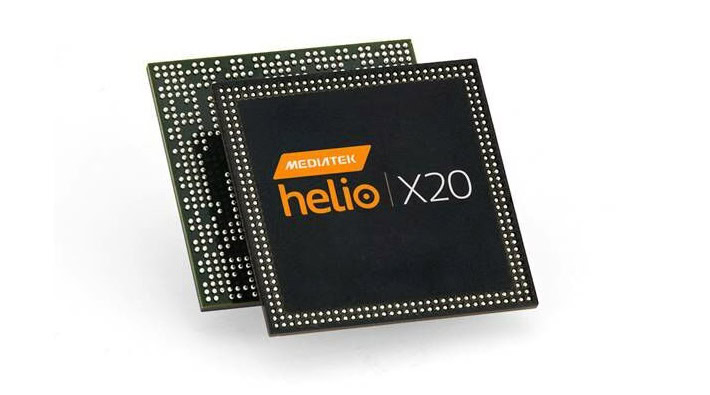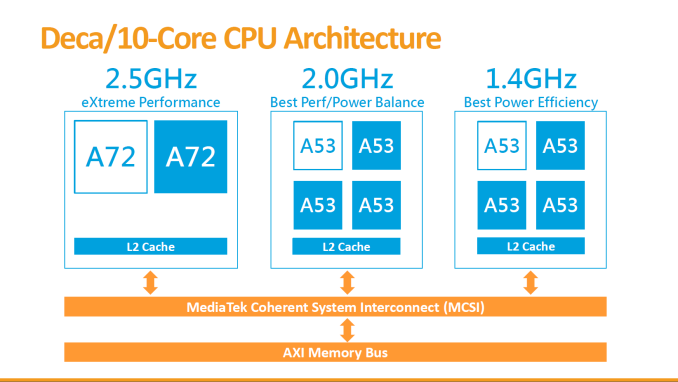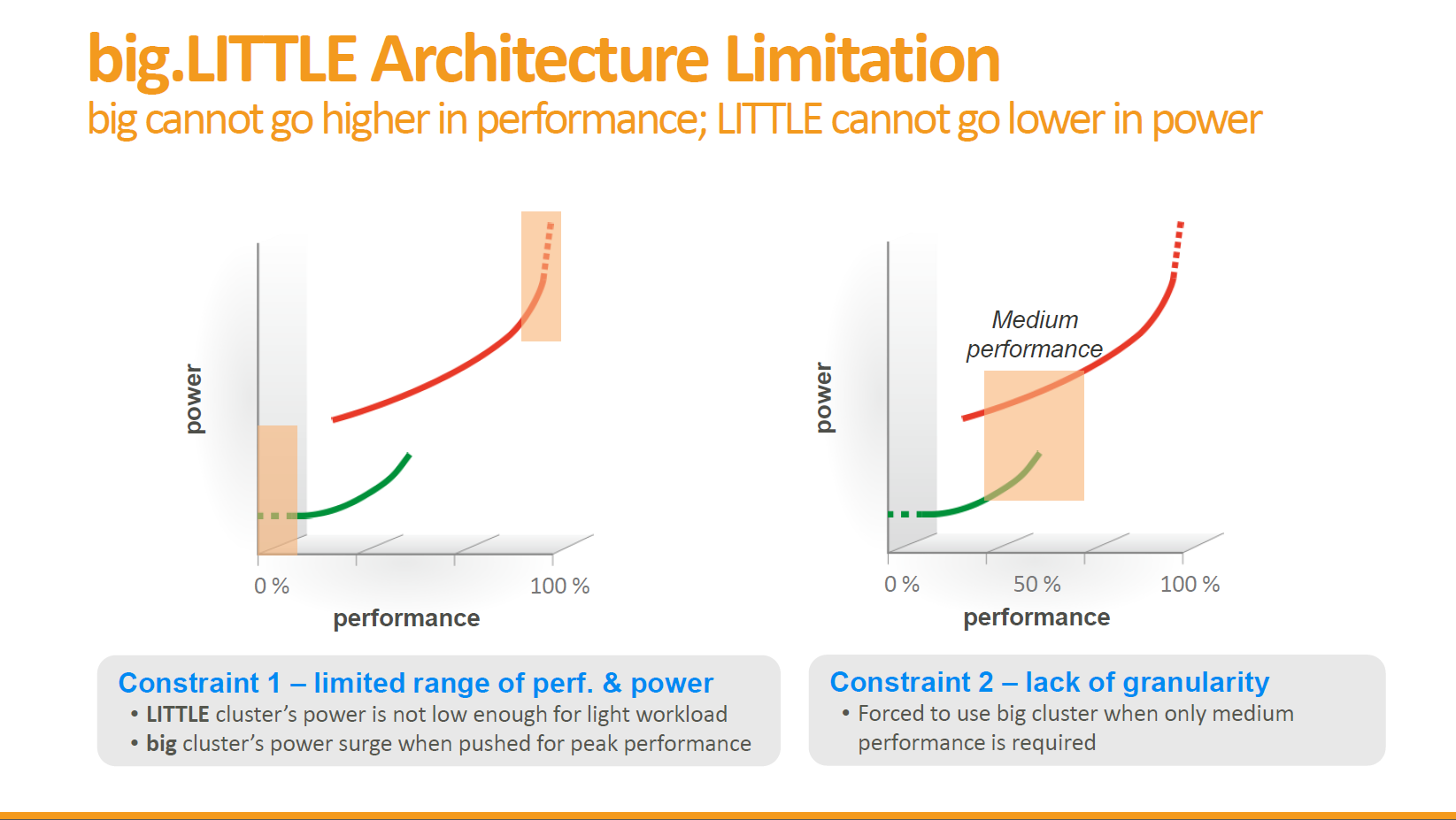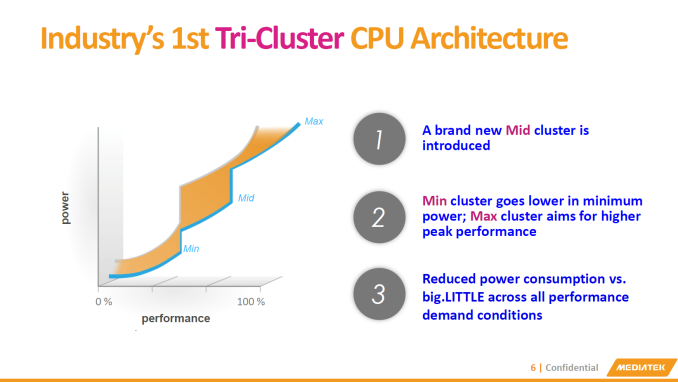Affiliate links on Android Authority may earn us a commission. Learn more.
10-core MediaTek Helio X20 is official
Published onMay 12, 2015

Last week, a leaked spec sheet gave us our first look at MediaTek’s Helio X20 mobile SoC and today the company has official announced its 10-core behemoth, the second chip in its X-series line up.
Just as the leak suggested, the X20 arranges its 10 CPU cores into a Tri-cluster big.LITTLE setup. There are two heavy duty new Cortex-A72 cores clocked at 2.5GHz, accompanied by a medium performance quad-core Cortex-A53 group clocked at 2.0GHz, and a further power efficient quad-core A53 group clocked at just 1.4GHz. To tie the clusters together, the company has developed its own MediaTek Coherent System Interconnect (MCSI), rather than making use of ARM’s CCI-500 which allows for up to 4 clusters.
This is certainly a more novel approach to big.LITTLE, but MediaTek states that this type of design lends itself to a 30 percent improvement in power consumption compared with a similar 2-cluster design. The idea is to scale even more effectively from small low power cores, through a quad-core mid-stage and right on up to a dual-core high performance configuration. The design makes use of heterogeneous processing, meaning that tasks can be dynamically allocated to any CPU core at any time. MediaTek uses its custom designed CorePilot as the task scheduler, which is designed around optimum power allocation.

The CPU is paired with dual channel 32-bit LPDDR3 memory interface, which runs at 933MHz. Although slower than the new LPDDR4 implementations found in the likes of the Exynos 7420 or Snapdragon 810, the X20’s RAM should be more than enough for standard 1080p devices and should run fine up to the maximum supported QHD display resolution.
ARM processing technology runs right through the SoC, as there’s a Mali-T880 MP4 GPU and integrated Cortex-M4 companion core used for various audio processing tasks, which supports specific DSP instruction and has an FPU. The low power Cortex-M4 handles audio decode, speech enhancement and voice recognition, even when the screen is off, to save on battery life.
As for the GPU, the X20 is believed to be the first chip to make use of ARM’s latest Mali-T880 graphics technology, although this is the only detail left unconfirmed. The SoC makes use of four shader cores for a mid-range performance target, and is clocked at 700MHz. For comparison, Samsung’s high-end Exynos 7420 makes use of an eight shader core Mali-T760, but the X20 should still offer performance in the area of last generation flagships. There has also likely been some compromise here on the amount of silicon space available after the number of CPU cores and also the thermal limit of the chip.
The X20 SoC packs in a number of other features that you would expect from a high-end mobile chip. Including, 2160p30 10-bit H.264/HEVC/VP9 decode, 2160p30 HEVC w/HDR encode, support for a single image processor up to 32MP or dual 13MP cameras, MediaTek’s CDMA2000 compatible integrated modem and Category 6 LTE speeds of 300Mbps download and 50 Mbps upload.
| MediaTek Helio X20 | MediaTek Helio X10 | Snapdragon 810 | Snapdragon 615 | |
|---|---|---|---|---|
CPU | MediaTek Helio X20 2x Cortex-A72 @ 2.5GHz 4x Cortex-A53 @ 2.0GHz 4x Cortex-A53 @ 1.4GHz | MediaTek Helio X10 4x Cortex-A53 @ 2.0GHz 4x Cortex-A53 @ 1.4GHz | Snapdragon 810 4x Cortex-A57 @ 2.0GHz 4x Cortex-A53 @ 1.6GHz | Snapdragon 615 4x Cortex-A53 @ 1.7GHz 4x Cortex-A53 @ 1.0GHz |
GPU | MediaTek Helio X20 Mali-T880 MP4 @ 700MHz | MediaTek Helio X10 PowerVR G6200 @700MHz | Snapdragon 810 Adreno 430 @ 650MHz | Snapdragon 615 Adreno 405 |
RAM | MediaTek Helio X20 2x 32-bit LPDDR3 @ 933MHz | MediaTek Helio X10 2x 32-bit LPDDR3 @ 933MHz | Snapdragon 810 2 x 64-bit LPDDR4 @ 1600MHz | Snapdragon 615 1 x 32-bit LPDDR3 @800MHz |
LTE | MediaTek Helio X20 LTE Cat. 6 | MediaTek Helio X10 LTE Cat. 4 | Snapdragon 810 LTE Cat. 9 | Snapdragon 615 LTE Cat. 4 |
ISP | MediaTek Helio X20 34MP Dual | MediaTek Helio X10 13MP | Snapdragon 810 55MP Dual | Snapdragon 615 21MP |
Video | MediaTek Helio X20 H.264/HEVC/VP9 decode, HEVC w/HDR encode | MediaTek Helio X10 H.264/HEVC/VP9 decode, HEVC encode | Snapdragon 810 H.264/HEVC decode, H.264/HEVC encode, | Snapdragon 615 HEVC/H.265 decode |
Process | MediaTek Helio X20 20nm | MediaTek Helio X10 28nm | Snapdragon 810 20nm | Snapdragon 615 28nm |
Seriously, why 10 cores?
You’re probably wondering if there’s really any point in a 10-core SoC for mobile devices. As our own Gary Sims mentioned in a previous post, energy efficiency is actually the target goal of these increasingly large multi-core processors. It may seem a little counter intuitive, but 10 cores doesn’t automatically improve performance. However, it does offer a lot more choice about what you can do with your workload.
Just like the commonplace mid-range octa-core chips, such as the Snapdragon 615 or MT6752, the two clusters of A53 cores aren’t designed equally. Apart from the lower clock speeds, the power efficient cluster can be built using a more energy optimized silicon layout and thinner wires, as the core doesn’t handle as much current. This saves on space, cost, and on-state power consumption compared with using eight identical cores, at the expense of some peak performance in those cores. However, you’re not going to find many eight threaded applications, so it’s a beneficial trade-off.

Furthermore, now consider the burst-like nature of most mobile CPU applications. With efficient task scheduling, a demanding burst can be completed on a high performance core with the following light process shifted to a low performance core, allowing for the power consuming core to be shut-off. This can actually be more efficient than typical clock frequency scaling, as the on-state power consumption is lower for a small Cortex-A53 core than a similarly clocked A57, A72 or even a larger cell A53.
By combining an energy efficient, high performance dual-core Cortex-A72 cluster with a medium and small Cortex-A53 design, MediaTek’s X20 can sustain higher peak performance, for games and burst tasks, whilst simultaneously creating a wider dynamic range of scheduling options for medium and low demanding tasks. The trade-off is the additional silicon space, development costs, and higher thermal potential of implementing a larger number of cores, the latter of which is why the use of a Cortex-A72 and 20nm manufacturing process is quite significant.

To summarize, not only does the X20 offer the energy saving benefits of smaller eight core chips, but throws in the peak performance available from ARM’s high-end cores. The X20 sits somewhere between the eight-core mid-range Cortex-A53 SoCs, such as the Snapdragon 615 or MediaTek X10, and the very high performance octa-core chips like the Exynos 7420 and Snapdragon 810, as it doesn’t quite match the top tier multitasking potential offered by a quad-core A72 or A57 design. However, for the vast majority of tasks the X20 has more than enough processing capabilities.
MediaTek’s latest design shows the range of possibilities available with big.LITTLE and demonstrates the type of design compromises on space, cost and power that all SoC manufacturers are facing. Although the X20 might not have everything it takes to beat the high-end performers, MediaTek’s latest offering will pose a serious challenge to the likes of the Snapdragon 808 and upcoming 620, and could be a serious contender in mid to high-end smartphones.